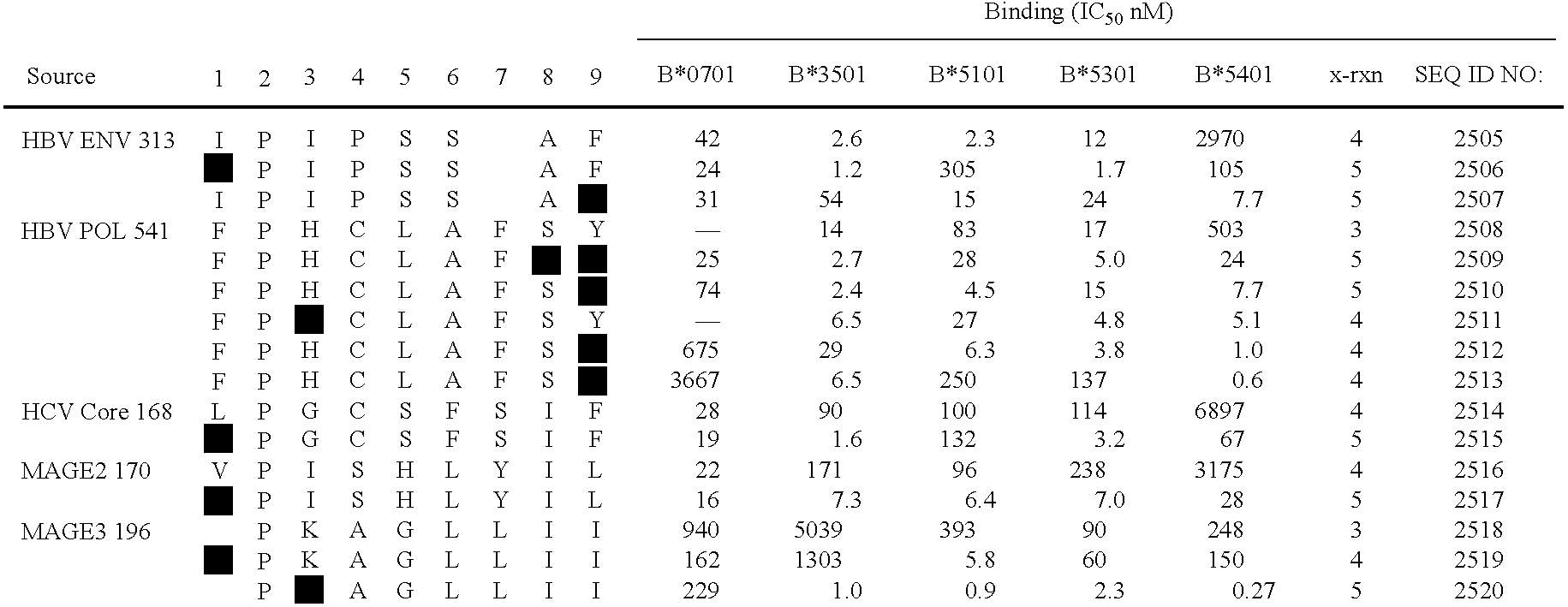Inducing cellular immune responses to hepatitis B virus using peptide and nucleic acid compositions
a technology of hepatitis b virus and composition, applied in the direction of p53 protein, peptides, viruses, etc., can solve the problems of formidable obstacles to the development of broadly efficacious epitope-based immunotherapeutics, inability to engineer the response in the same way with traditional approaches, and difficulty in achieving non-genetically biased coverage of a population. effective and non-genetically biased coverage of a population is a task of considerable complexity
- Summary
- Abstract
- Description
- Claims
- Application Information
AI Technical Summary
Benefits of technology
Problems solved by technology
Method used
Image
Examples
example 1
HLA Class I Binding Assays
The following example of peptide binding to HLA-A3 supertype molecules demonstrates quantification of binding affinities of HLA class I peptides. Analogous binding assays can be performed for other peptides that bind class I or class II HLA molecules. Furthermore, binding assays can be performed with peptides that are not motif-bearing.
For example, the affinity of peptides bearing an HLA-A3 supermotif was determined as follows. Epstein-Barr virus (EBV)-transformed homozygous cell lines were used as sources of class I molecules. Cell lines include, e.g., GM3107 (A3, B7; Human Genetic Mutant Repository); BVR (A11, B35.3, Cw4; Human Genetic Mutant Repository); SPACH (A31, B62, Cw1 / 3; ASHI Repository Collection); LWAGS (A*3301, B14, and Cw8; ASHI Repository Collection) (Bodmer, et al., Hum. Immunol. 43:149, 1995), and a C1R transfectant characterized by Dr. Walter Storkus (University of Pittsburgh) for the isolation of A*6801. Cell lines were maintained as prev...
example 2
Implementation of the Extended Supermotif to Improve the Binding Capacity of Native Peptides by Creating Analogs
HLA motifs and supermotifs (comprising primary and / or secondary residues) are useful in preparing highly cross-reactive native peptides, as demonstrated herein. Moreover, the definition of HLA motifs and supermotifs also allows one to engineer highly cross-reactive epitopes by identifying residues within a native peptide sequence which can be analoged, or "fixed", to confer upon a peptide certain characteristics, e.g., greater cross-reactivity within the group of HLA molecules that make-up the supertype, and / or greater binding affinity for some or all of those HLA molecules Examples of analog peptides that exhibit modulated binding affinity are provided.
Analogs representing primary anchor single amino acid residues substituted with I residues at the C-terminus of two different B7-like peptides (HBV env 313 and HBV pol 541) were synthesized and tested for their B7-supertype...
example 3
Induction of HLA-Restricted CTL By Subcutaneous Priming With HBV Peptide in Incomplete Freund's Adiuvant (IFA)
The immunogenicity of HLA class I binding peptides can be assessed in vivo as described in, e.g., Sette et al. J. Immunol. 153:5586-5592 (1994). This example illustrates such a procedure, whereby subcutaneous injection of HBV peptide in Incomplete Freund's Adjuvant (IFA) can be used to induce HBV-specific CTL in mice that are transgenic for a human HLA allele such as the human HLA-A11 allele.
Priming and In Vitro Restimulation: Mice that are transgenic for HLA-A11, (e.g. HLA-A11 / K.sup.b strain) are injected with 100 microliters of an emulsion of purified HBV peptide in IFA. The purified peptide comprises an A11 motif, and is selected from the preferred peptides listed in Table XVI or, alternatively, may be an analog peptide. The peptide epitope (50 .mu.g / mouse) and equimolar amounts of the helper epitope HBV core 128-140 (140 .mu.g / mouse) are dissolved in PBS / 5% DMSO, emulsif...
PUM
| Property | Measurement | Unit |
|---|---|---|
| dissociation constant | aaaaa | aaaaa |
| dissociation constant | aaaaa | aaaaa |
| incubation time | aaaaa | aaaaa |
Abstract
Description
Claims
Application Information
 Login to View More
Login to View More - R&D
- Intellectual Property
- Life Sciences
- Materials
- Tech Scout
- Unparalleled Data Quality
- Higher Quality Content
- 60% Fewer Hallucinations
Browse by: Latest US Patents, China's latest patents, Technical Efficacy Thesaurus, Application Domain, Technology Topic, Popular Technical Reports.
© 2025 PatSnap. All rights reserved.Legal|Privacy policy|Modern Slavery Act Transparency Statement|Sitemap|About US| Contact US: help@patsnap.com


